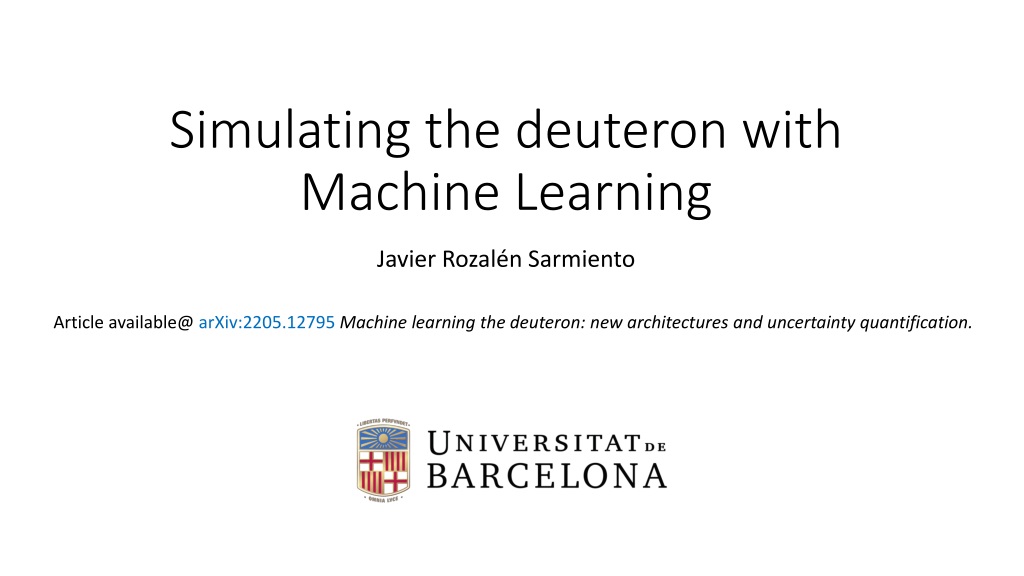

Replay
0 likes | 14 Views
Utilizing machine learning techniques, a study by Javier Rozalén Sarmiento explores novel architectures for simulating the deuteron in nuclear physics. The research focuses on training artificial neural networks with variational approaches to tackle the deuteron problem, providing insights on uncertainties and error analysis. By leveraging these advancements, the potential for enhancing nuclear physics simulations, particularly in large nuclei systems, is highlighted.

E N D
Simulating the deuteron with Machine Learning Javier Rozalén Sarmiento Article available@ arXiv:2205.12795 Machine learning the deuteron: new architectures and uncertainty quantification.
A bit of context... A bit of context... - The use of Machine Learning techniques in physics is proving useful [1,2]. Data Data Data Data Data Data Data Data ? Data Prediction! Data Data Data Data Data Data Data [1] G. Carleo, M. Troyer et al, 2019, Science. 355. (Preprint @ arXiv:1606.02318) [2] D. Pfau, J. S. Spencer et al, 2020, Phys. Rev. Res. 2. (Preprint @ arXiv:1909.02487) 2
A bit of context... A bit of context... - The biggest projects to this day are in quantum chemistry [2]. FermiNet [2] D. Pfau, J. S. Spencer et al, 2020, Phys. Rev. Res. 2. (Preprint @ arXiv:1909.02487) 3
Existential question Existential question Can we seize these advancements to do nuclear physics?
Artificial Neural Networks (ANNs) Artificial Neural Networks (ANNs) Hidden layer ? ? Output layer Input layer 1 1+?−? Sigmoid · (2) 2,?1 ?1 (1) 1,?1 ?1 · log 1 + exp(?) Softplus (2) 2,?2 (1) 1,?2 ?2 ?2 ?(?;?,?) ? ... (2) 2,?3 (1) ?3 1,?3 ?3 (2) 2,?4 ?4 (1) 1,?4 ?4 ? Weights ?? ?hid (1) (2) 2? ?? 1? + ?? ? ?;?,? = ?? + ?? ?? Bias ?=1 ?(?(?)) Activation function
Variational Artificial Neural Networks (VANNs) Variational Artificial Neural Networks (VANNs) ??,?? ??,?? ? · ANN = |?ANN ?;?,? > ??(?) · ANN weights = ? parameters Core idea “Training” + numerical minimisation algorithm or Optimizer “Learning” Minimise the function: 6 J Rozalén Sarmiento, A Rios, J W T Keeble, Machine learning the deuteron: new architectures and uncertainty quantification, arXiv:2205.12795
The deuteron problem The deuteron problem Physical system: deuteron Formalism S-wave ? = ? + ? Schrödinger equation ? = 0 ? ? D-wave ? =2 ??= 1+ ???= −2.2267 MeV Coordinates Spherical coordinates in momentum space ? = |?p− ?n| 7 J Rozalén Sarmiento, A Rios, J W T Keeble, Machine learning the deuteron: new architectures and uncertainty quantification, arXiv:2205.12795
Different Architectures Different Architectures 8 J Rozalén Sarmiento, A Rios, J W T Keeble, Machine learning the deuteron: new architectures and uncertainty quantification, arXiv:2205.12795
Training example Training example Network hyperparameters: − ?hid= 20 neurons − Learning rate = 10−2 Optimizer = RMSProp Developed with 9
Results: Energies and fidelities Results: Energies and fidelities 10 J Rozalén Sarmiento, A Rios, J W T Keeble, Machine learning the deuteron: new architectures and uncertainty quantification, arXiv:2205.12795
Results: Error analysis Results: Error analysis Stochastic error + 10 times 11 J Rozalén Sarmiento, A Rios, J W T Keeble, Machine learning the deuteron: new architectures and uncertainty quantification, arXiv:2205.12795
Results: Energies and fidelities + errors Results: Energies and fidelities + errors Oscillation error Oscillation error Stochastic error Stochastic error 12 J Rozalén Sarmiento, A Rios, J W T Keeble, Machine learning the deuteron: new architectures and uncertainty quantification, arXiv:2205.12795
Results: Wave functions Results: Wave functions 13 J Rozalén Sarmiento, A Rios, J W T Keeble, Machine learning the deuteron: new architectures and uncertainty quantification, arXiv:2205.12795
Towards the simulation of large nuclei Towards the simulation of large nuclei Many-body (fermionic) systems ??,?? ??,?? ??,?? ??,?? ??,?? ??,?? ??,?? ??,?? ?(?) ?(?) ⋮ ?? ??,?? ??,?? ?? ?? ??,?? ??,?? ?(?) ?(?) ?? ?? ?(?) ?(?) ?? ?? ?(?) ??? ??? ??(?) The scaling is no longer exponential! 14
Towards the simulation of large nuclei Towards the simulation of large nuclei [4] [4]. E M Nordhagen et al, Hidden-nucleons neural-network quantum states for the nuclear many-body problem, arXiv:2210.00365 15
Moral Moral - Variational Artificial Neural Networks rule - With great parameter number comes great responsability [6] [6]. Raimi, S., Spiderman 1 (-ish) 16